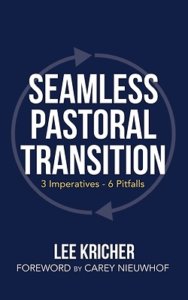How does the leadership transition from Moses to Joshua provide insights for leaders today? Lee Kricher offers insights on this seamless leadership transition.
Succession planning and preserving continuity of leadership are both evident in the most extensive biblical record of leadership transition — the account of the transition from Moses to Joshua. Several key principles emerge when this leadership transition is studied.
Moses and Joshua model shared leadership.
Knowing how God had revealed Godself to him and used him, Moses seemed to have embraced a One Leader–Many Followers paradigm, a leadership paradigm in which all meaningful leadership is built around a central leader. That is understandable. He was the catalyst for miracles that led to the stunning release of the Jewish people from slavery in Egypt. That all changed when he got a visit from his father-in-law, Jethro, who asked “What is this that you are doing for the people? Why do you sit alone, while all the people stand around you from morning until evening? … What you are doing is not good.” Moses likely had a relatively close relationship with Jethro. He listened to Jethro’s advice. He began to share meaningful leadership with others, appointing judges to resolve the vast majority of Israel’s issues. (Exodus 18:18–26) While Moses did not abdicate his role as Israel’s leader, he gave many others opportunities to lead.
Two outstanding leaders that Moses identified and trusted as leaders were Caleb and Joshua. Joshua led a militia group to fight the Amalekites. Moses took Joshua with him for at least a portion of his first ascent to and descent from Mount Sinai. Moses chose Joshua and Caleb as two of the twelve men who scouted out the land of Canaan. In short, Moses came to understand the need to intentionally elevate others to take on visible leadership roles that supplemented his leadership role. Moses exchanged the One Leader–Many Followers paradigm for a commitment to identify and develop many leaders and share leadership in a meaningful way. When it was time for Moses to hand off his leadership role in Israel, Joshua emerged from among many proven leaders of Israel.
The leadership transition from Moses to Joshua was planned.
Then Moses summoned Joshua and said to him in the sight of all of Israel, “Be strong and bold, for you are the one who will go with this people into the land that the Lord has sworn to their ancestors to give them, and you will put them in possession of it. It is the Lord who goes before you. He will be with you; he will not fail you or forsake you. Do not fear or be dismayed.” (Deuteronomy 31:78)
Moses clearly felt that he had a God-given responsibility to identify the leader who would take his place. Though there were other effective leaders in the nation of Israel, Moses “summoned” Joshua. There is a critical question that every leader must ask — “Am I responsible for what happens after I leave my leadership role?” Moses would have answered that question in the affirmative. He could not guarantee what would happen to the nation of Israel after his death, but he could make sure that the people were left with a proven, effective leader.
Moses was transparent and empowered Joshua.
The leadership transition was transparent. The people of Israel were not left in the dark about who would lead them when Moses was gone. For years, Moses had empowered Joshua with leadership opportunities in the nation of Israel. His clear and unwavering support for Joshua paved the way for Joshua’s success in leading Israel into the promised land of Canaan. The appointment of Joshua by Moses was done “in the sight of all of Israel.” (v.7). Joshua did not have to convince Israel after Moses was gone that he had been chosen in private by Moses. Those most affected by the leadership transition were eyewitnesses as Moses commissioned Joshua as their next leader.
Moses paved the way for Joshua.
Moses paved the way for Joshua’s future leadership role by providing him with highly visible leadership opportunities. By the time Joshua was commissioned as the leader of the nation of Israel, he was already established as a credible and respected leader. According to Haubert and Clinton, “Joshua’s ongoing association with Moses at a mentoring level did at least two things. First, it promoted Joshua’s development. Through tandem training Joshua was inculcating skills, attitudes, and values needed for top level leadership. Second, it prepared the people for Joshua’s installation. Whenever they saw Moses, Joshua was not far away. This gave Joshua credibility and created a positive perception of his status.” Moses also paved the way for Joshua by making sure that the leadership transition was simple, straightforward, and very public.
The leadership transition from Moses to Joshua was seamless.
The leadership transition was seamless. This was a deliberate choice on the part of Moses, who chose Joshua to take over the leadership of Israel in a transition that would involve no gap in time between the leaders. Joshua’s leadership began the moment Moses’ leadership ended. Moses clearly believed that a seamless leadership transition was God’s will and in the best interests of God’s people.
Moses and Joshua model humility.
The clear and unwavering support that Moses showed for Joshua certainly required humility on the part of Moses. But this critical leadership virtue of humility was not just demonstrated by Moses, it was also demonstrated by Joshua. Joshua showed clear and unwavering support and respect for Moses. Joshua looked to the future by building on and honoring the past. Given that Moses and Joshua both modeled humility in how they honored one another, it is no wonder that the people of Israel who loved and respected Moses showed the same love and respect for Joshua.
There are many insights that can be drawn from the biblical record of their leadership transition, including the timeless virtues of sharing leadership, paving the way, and modeling humility that they demonstrated — virtues that can be instructive to leaders in transition today.
 This article is adapted from Seamless Pastoral Transition: 3 Imperatives – 6 Pitfalls (Xulon Press, 2022) by Lee Kricher. The book is available through the publisher and at Amazon and Cokesbury.
This article is adapted from Seamless Pastoral Transition: 3 Imperatives – 6 Pitfalls (Xulon Press, 2022) by Lee Kricher. The book is available through the publisher and at Amazon and Cokesbury.
Related Resources
- 50 Ways to Improve Pastoral Transitions
- Leading Like Moses: 4 Ways to Know What to Delegate by Micah Fries and Jeremy Maxfield
- 5 Leadership Insights from Jethro by Doug Powe






